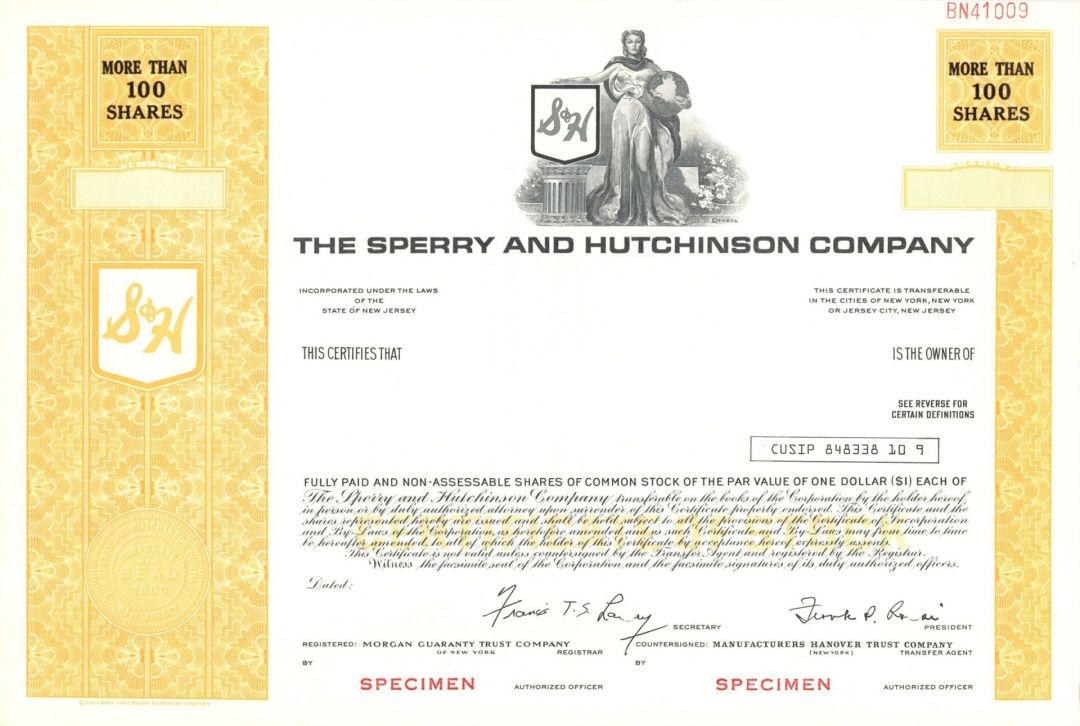Sperry and Hutchinson Co. - 1900 Specimen Stock Certificate
Inv# SE3780 Specimen StockNew York
Specimen Stock printed by Security-Columbian Banknote Company. Please specify color.
S&H Green Stamps was a line of trading stamps popular in the United States from 1896 until the late 1980s. They were distributed as part of a rewards program operated by the Sperry & Hutchinson company (S&H), founded in 1896 by Thomas Sperry and Shelley Byron Hutchinson. During the 1960s, the company issued more stamps than the U.S. Postal Service, and distributed 35 million catalogs a year. Customers received stamps at the checkout counter of supermarkets, department stores, and gasoline stations among other retailers, that could then be redeemed for products from the catalog. Top Value Stamps ceased operations in the early 1980s, after which S&H would accept savings books for those left with unredeemed Top Value books, before S&H themselves also ceased business. S&H Green Stamps had several competitors, including Greenbax Stamps offered by Piggly Wiggly, Gold Bell Gift Stamps (in the Midwest), Triple S Stamps (offered by Grand Union Supermarkets), Gold Bond Stamps, Blue Chip Stamps, Plaid Stamps (a project of A&P Supermarkets), Top Value Stamps, King Korn Stamps, Quality Stamps, Gunn Brothers given by Safeway, Buccaneer, and Eagle Stamps (a project of several divisions of the May Department Stores Co. of St. Louis, Missouri, and offered, notably, by May Company stores, supermarkets, drug stores, gas stations, and dry cleaners in the Cleveland, Ohio, area).
Sperry & Hutchinson began offering stamps to U.S. retailers in 1896. The retail organizations that distributed the stamps were primarily supermarkets, gasoline filling stations, and stores. They bought the stamps from S&H and gave them as bonuses to shoppers based on the dollar amount of a purchase. A 1963 magazine article stated that the average supermarket paid $2.45 for the stamps needed to fill one collector book. The stamps were issued in denominations of one, ten, and fifty points, perforated with a gummed reverse. As shoppers accumulated the stamps, they moistened the reverse and mounted them in collector's books, which were provided free by S&H. The books contained 24 pages and filling a page required 50 points, so each book contained 1,200 points. Shoppers could then exchange filled books for premiums, including housewares and other items, from the local Green Stamps store or catalog. Each premium was assigned a value expressed by the number of filled stamp books required to obtain it. Read more at https://en.wikipedia.org/wiki/S%26H_Green_Stamps
Stock and Bond Specimens are made and usually retained by a printer as a record of the contract with a client, generally with manuscript contract notes such as the quantity printed. Specimens are sometimes produced for use by the printing company's sales team as examples of the firms products. These are usually marked "Specimen" and have no serial numbers.










Ebay ID: labarre_galleries